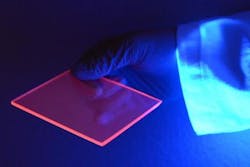Solar photovoltaic windows rely on inexpensive silicon quantum dots
Luminescent solar concentrators (LSCs), which are flat panes of mostly transparent material that take sunlight (both diffuse and directed) and concentrate it at the panes' edges, can be used as "photovoltaic windows," which, as the name makes clear, collect solar energy while serving as ordinary windows. Now, researchers at the Università degli Studi di Milano-Bicocca and Glass to Power Srl (both of Milano, Italy) and the University of Minnesota (Minneapolis, MN) are lowering the potential cost of such windows by using silicon nanoparticles as the fluorescent absorber/emitter in the LSC windows.1
Until recently, the best results had been achieved using relatively complex nanostructures based either on potentially toxic elements, such as cadmium or lead, or on rare substances like indium, which is already massively utilized for other technologies. Silicon is abundant in the environment and nontoxic. It also works more efficiently by absorbing light at different wavelengths than it emits. However, silicon in its conventional bulk form, does not emit light or luminesce.
Absorption and emission wavelengths different
"In our lab, we 'trick' nature by shrinking the dimension of silicon crystals to a few nanometers," says University of Minnesota mechanical engineering professor Uwe Kortshagen, inventor of the process for creating silicon nanoparticles and one of the senior authors of the study. "At this size, silicon’s properties change and it becomes an efficient light emitter, with the important property not to re-absorb its own luminescence. This is the key feature that makes silicon nanoparticles ideally suited for LSC applications."
Researchers say the optical features of silicon nanoparticles and their nearly perfect compatibility with the industrial process for producing the polymer LSCs create a clear path to creating efficient photovoltaic windows that can capture more than 5% of the sun’s energy at low cost for windows 1 m2 in size.
Glass to Power Srl is a commercial spinoff with staff members from the Università degli Studi di Milano-Bicocca; the company aims to develop and commercially produce LSC photovoltaic windows.
Sources:
https://twin-cities.umn.edu/news-events/dream-energy-collecting-windows-one-step-closer-reality
http://www.glasstopower.com/en/
REFERENCE:
1. Francesco Meinardi et al., Nature Photonics (2017); doi:10.1038/nphoton.2017.5
About the Author
John Wallace
Senior Technical Editor (1998-2022)
John Wallace was with Laser Focus World for nearly 25 years, retiring in late June 2022. He obtained a bachelor's degree in mechanical engineering and physics at Rutgers University and a master's in optical engineering at the University of Rochester. Before becoming an editor, John worked as an engineer at RCA, Exxon, Eastman Kodak, and GCA Corporation.

